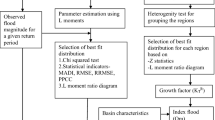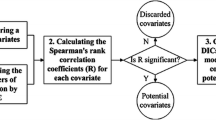Abstract
Selection of a flood frequency distribution and associated parameter estimation procedure is an important step in flood frequency analysis. This is however a difficult task due to problems in selecting the best fit distribution from a large number of candidate distributions and parameter estimation procedures available in the literature. This paper presents a case study with flood data from Tasmania in Australia, which examines four model selection criteria: Akaike Information Criterion (AIC), Akaike Information Criterion—second order variant (AICc), Bayesian Information Criterion (BIC) and a modified Anderson–Darling Criterion (ADC). It has been found from the Monte Carlo simulation that ADC is more successful in recognizing the parent distribution correctly than the AIC and BIC when the parent is a three-parameter distribution. On the other hand, AIC and BIC are better in recognizing the parent distribution correctly when the parent is a two-parameter distribution. From the seven different probability distributions examined for Tasmania, it has been found that two-parameter distributions are preferable to three-parameter ones for Tasmania, with Log Normal appears to be the best selection. The paper also evaluates three most widely used parameter estimation procedures for the Log Normal distribution: method of moments (MOM), method of maximum likelihood (MLE) and Bayesian Markov Chain Monte Carlo method (BAY). It has been found that the BAY procedure provides better parameter estimates for the Log Normal distribution, which results in flood quantile estimates with smaller bias and standard error as compared to the MOM and MLE. The findings from this study would be useful in flood frequency analyses in other Australian states and other countries in particular, when selecting an appropriate probability distribution from a number of alternatives.









Similar content being viewed by others
References
Bates BC, Rahman A, Mein RG, Weinmann PE (1998) Climatic and physical factors that influence the homogeneity of regional floods in south-eastern Australia. Water Resour Res 34(12):3369–3382
Bernier J (1967) Sur la thėorie du renouvellement et son application en hydrologie. Electricitė de France, Hyd 67(10):32 (in French)
Bickel PJ, Docksum KA (1977) Mathematical statistics: basic ideas and selected topics. Holden-day, San Francisco
Bobėe B, Cavidas G, Ashkar F, Bernier J, Rasmussen P (1993) Towards a systematic approach to comparing distributions used in flood frequency analysis. J Hydrol 142:121–136
Burham KP, Anderson DR (2002) Model selection and multi model inference, 2nd edn. Springer, New York
Calenda G, Mancini CP, Volpi E (2009) Selection of the probabilistic model of extreme floods: the case of the River Tiber in Rome. J Hydrol 27:1–11
Casella G, George EI (1992) Explaining the Gibbs sampler. Am Stat Assoc 46(3):167–174
Chebana F, Ouarda TBMJ (2008) Depth and homogeneity in regional flood frequency analysis. Water Resour Res 44:W11422. doi:10.1029/2007WR006771
Cunanne C (1973) A particular comparison of annual maxima and partial duration series methods of flood frequency prediction. J Hydrol 18:257–271
Cunnane C (1989) Statistical distributions for flood frequency analysis. WMO No. 718, WMP, Geneva
Di Baldassarre G, Laio F, Montanari A (2008) Design flood estimation using model selection criteria. Phys Chem Earth. doi:10/1016/j.pce.2008.10.066
Fernandes W, Naghettini M, Loschi R (2010) A Bayesian approach for estimating extreme flood probabilities with upper-bounded distribution functions. Stoch Environ Res Risk A 24. doi:10.1007/s00477-010-0365-4
Geman S, Geman D (1984) Stochastic relaxation, Gibbs distributions and the Bayesian restoration of images. IEEE Trans Pattern Anal Mach Intell 6:721–741
Grubbs FE, Beck G (1972) Extension of sample sizes and percentage points for significance tests of outlying observations. Technometrics 4(14):847–853
Haddad K, Rahman A (2008) Investigation on at-site flood frequency analysis in south-east Australia. J Inst Eng Malays 69(3):59–64
Hastings WK (1970) Monte Carlo sampling methods using markov chains and their applications. Biometrika 57:97–109
Hosking JRM (1990) L-moments analysis and estimation of distributions using linear combinations of order statistics. J R Stat Soc Ser B Methodol 52(2):105–124
Hosking JR, Wallis JR (1993) Some statistics useful in regional frequency analysis. Water Resour Res 29(2):271–281
Hosking JR, Wallis JR (1997) Regional frequency analysis: an approach based on L-moments. Cambridge University Press, Cambridge
Institution of Engineers Australia (IE Aust) (1987, 2001) In: Pilgrim DH (ed) Australian Rainfall and Runoff: a guide to flood estimation, vol. 1. I. E. Aust. Canberra
Kendall MG (1970) Rank correlation methods, 4th edn. Griffen, London
Kuczera G (1982) Combining site-specific and regional information: an empirical Bayes approach. Water Resour Res 18(2):306–314
Kuczera G (1983a) A Bayesian surrogate for regional skew in flood frequency analysis. Water Resour Res 1919(3):821–832
Kuczera G (1983b) Effect of sampling uncertainity and spatial correlation on an empirical Bayes procedure for combining site and regional information. J Hydrol 65:373–398
Kuczera G (1999) Comprehensive at-site flood frequency analysis using Monte Carlo Bayesian inference. Water Resour Res 35(5):1551–1557
Kuczera G, Parent E (1998) Monte Carlo assessment of parameter uncertainty in conceptual catchment models: the Metropolis algorithm. J Hydro 211(1–4):69–85
Laio F (2004) Cramer-von Mises and Anderson-Darling goodness of fit tests for extreme value distributions with unknown parameters. Water Resour Res 40:W09308. doi:10.1029/2004WR003204
Laio F, Di Baldassarre G, Montanari A (2009) Model selection techniques for the frequency analysis of hydrological extremes. Water Resour Res 45:W07416. doi:10.1029/2007/WR006666
Lim YH, Lye LM (2003) Regional flood estimation for ungauged basins in Sarawak, Malaysia. Hydrol Sci J 48(1):79–94
Madsen H, Rasmussen PF, Rosbjerg D (1997) Comparison of annual maximum series and partial duration series methods for modeling extreme hydrological events 1: at-site modeling. Water Resour Res 33(4):747–757
Markiewicz I, Strupczewski WG, Kochanek K, Singh V (2006) Discussion of Non-stationary pooled flood frequency analysis. J Hydrol 276:210–223
Martins ES, Stedinger JR (2000) Generalized maximum likelihood GEV quantile estimators for hydrologic data. Water Resour Res 36(3):737–744
McGilchrist CA, Woodyer KD (1975) Note on a distribution free CUSUM technique. Technometrics 17(3):321–325
Meshgi A, Khalili D (2009a) Comprehensive evaluation of regional flood frequency analysis by L-abd LH-moments 1 a re-visit to regional homogeneity. Stoch Environ Res Risk A 23:119–135. doi:10.1007/s00477-007-0201-7
Meshgi A, Khalili D (2009b) Comprehensive evaluation of regional flood frequency analysis by L-abd LH-moments. II. Development of LH-moments parameters for the generalized Pareto and generalised logistic distributions. Stoch Environ Res Risk A 23:137–152. doi:10.1007/s00477-007-0201-7
Metropolis N, Rosenbluth AW, Teller AH, Teller E (1953) Equations of state calculations by fast computing machines. J Chem Phys 21:1087–1092
Micevski T, Kuczera G (2008) A general and practical Bayesian procedure for regional and at-site flood frequency analysis. In: Proceedings of water down under, Adelaide, Australia
Mitosek HT, Strupczewski WG, Singh VP (2006) Three procedures for selection of annual flood peak distribution. J Hydrol 323:57–73
Natural Environment Research Council (NERC) (1975). Flood studies report. NERC, London
Onoz B, Bayazit M (1995) Best-fit distribution of largest available flood samples. J Hydrol 167:195–204. doi:10.1016/0022-1694(94)02633-M
Reis R Jr, Stedinger R (2005) Bayesian MCMC flood frequency analysis with historical information. J Hydrol 313:97–116
Ribatet R, Sauquet E, Michel-Grėsillon J, Ouarda TBMJ (2007) A regional Bayesian POT model for flood frequency analysis. Stoch Environ Res Risk A 21:327–339. doi:10.1007/s00477-006-0068-z
Rosbjerg D, Madsen H (2008) Uncertainty measures of regional flood frequency estimators. J Hydrol 167(1–4):209–224
Srikanthan R, McMahon TA (1981) Log Pearson III distribution–effect of dependence, distribution parameters and sample size on peak annual flood estimates. J Hydrol 52(1/2):149–159
Stedinger JR (1980) Fitting lognormal distributions to hydrologic data. Water Resour Res 16(3):481–490
Stedinger JR, Vogel RM, Foufoula-Georgiou E (1992) Frequency analysis of extreme events. In: Maidment DR (ed) Handbook of hydrology. McGraw-Hill, New York
Strupczewski WG, Singh VP, Feluch W (2001) Non-stationarity approach to at-site flood frequency modeling: I. Maximum likelihood estimation. J Hydrol 248:123–142. doi:10.1016/S0022-1694(01)00397-3
Strupczewski WG, Singh VP, Weglarczyk S (2002) Asymptotic bias of estimation methods caused by the assumption of false probability distributions. J Hydrol 258:122–148. doi:10.1016/S0022-1694(01)00563-7
Vogel RM, McMahon TA, Chiew FHS (1993) Flood flow frequency model selection in Australia. J Hydrol 146:421–449
Wang QJ (1997) LH moments for statistical analysis of extreme events. Water Resour Res 33(12):2841–2848
Wood EF, Rodriguez-Iturbe I (1975) Bayesian inference and decision making for extreme hydrological events. Water Resour Res 11(4):533–542
Yang T, Yu Xu C, Xi Shao Q, Chen X (2010) Regional flood frequency and spatial pattern analysis in the Pearl River Delta region using L-moments approach. Environ Res Risk A 24:165–182. doi:10.1007/s00477-009-0308-0
Zucchini W (2000) An introduction to model selection. J Math Psychol 44:41–61
Acknowledgments
The authors would like to thank Hydro Tasmania for providing the data for this study as part of the development of regional flood frequency estimation techniques that are being undertaken for revision of Book 4 Australian Rainfall and Runoff. The authors would also like to thank Department of Climate Change and Engineers Australia for providing financial support for this research and Dr Fiona Ling, Professor George Kuczera, Associate Professor James Ball, Mr Erwin Weinmann, Dr William Weeks and Mr Mark Babister for their input to the project. Finally, the authors would like to acknowledge the comments and suggestions by three anonymous reviewers which have helped to improve the paper notably.
Author information
Authors and Affiliations
Corresponding author
Rights and permissions
About this article
Cite this article
Haddad, K., Rahman, A. Selection of the best fit flood frequency distribution and parameter estimation procedure: a case study for Tasmania in Australia. Stoch Environ Res Risk Assess 25, 415–428 (2011). https://doi.org/10.1007/s00477-010-0412-1
Published:
Issue Date:
DOI: https://doi.org/10.1007/s00477-010-0412-1




